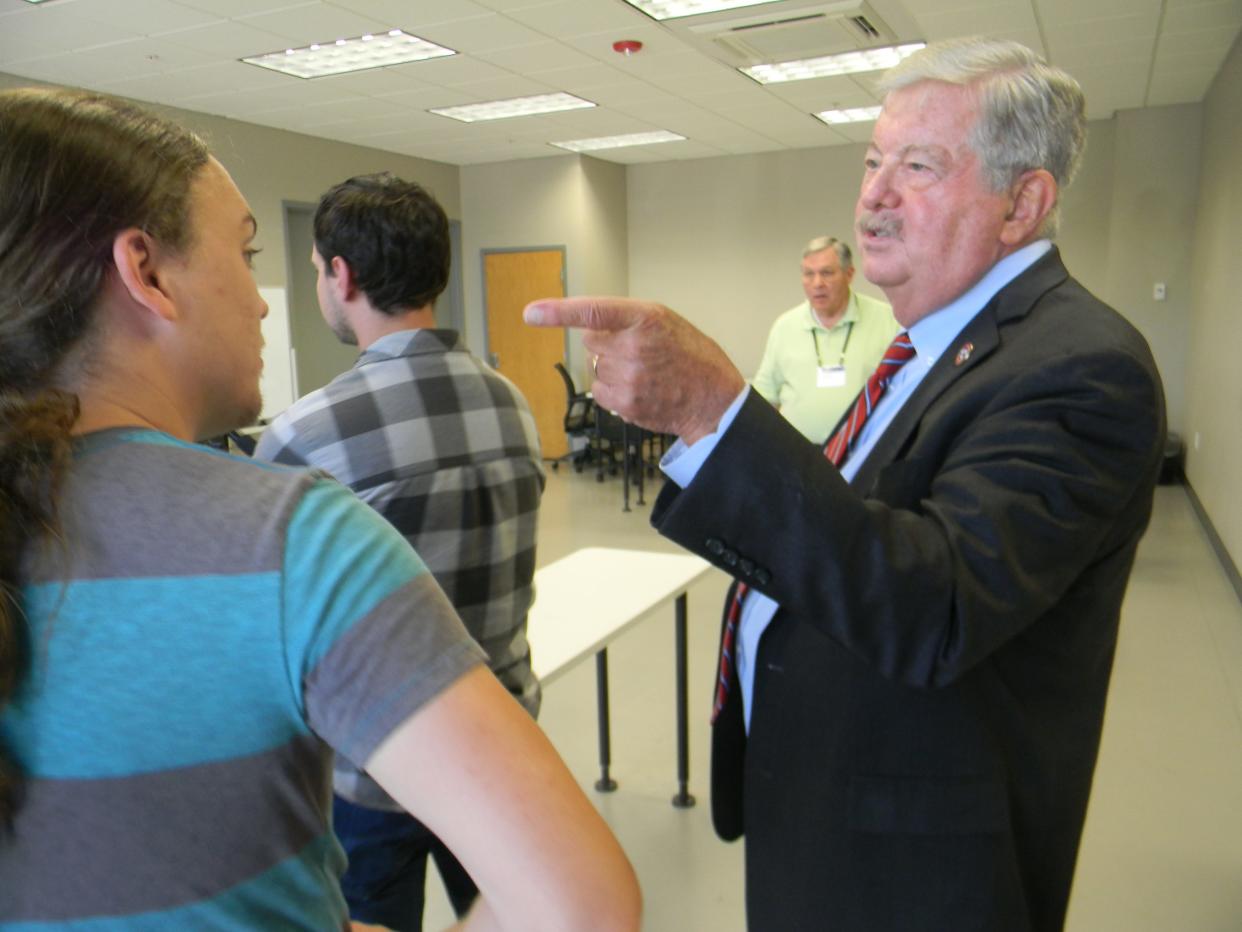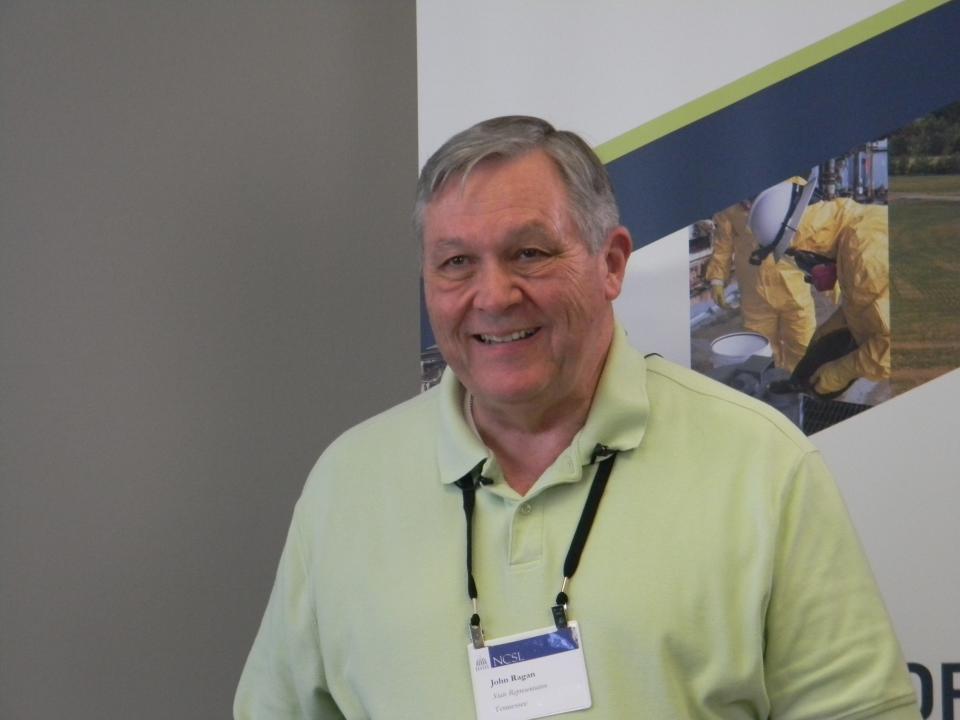Ragan, McNally meet with other state legislators on nuclear power, issues
- Oops!Something went wrong.Please try again later.
- Oops!Something went wrong.Please try again later.

A group of legislators from across the country recently toured East Tennessee sites to learn about nuclear technology and issues.
It was the Nuclear Legislative Working Group of the National Conference of State Legislators, a group that works with nuclear issues in general, both involving weapons and peaceful energy. Tennessee Rep. John Ragan, R-Oak Ridge, co-chairs the group, along with Illinois Sen. Mattie Hunter, a Democrat who represents the state's Third District, which includes Chicago.
While Tennessee Lt. Gov. Randy McNally, R-Oak Ridge, is not part of the group, he said he met with them at a reception during their visit.
Ragan and McNally spoke to reporters about the visit and nuclear technology during a press conference at federal nuclear cleanup contractor UCOR's office at 701 Scarboro Road.

"It's been a great deal of entertainment and pride for me. I love showing off my hometown and my home state," Ragan said, adding that he heard some compliments on the scenery.
The group's visit included Y-12 National Security Complex in Oak Ridge and Watts Bar Nuclear Plant in Rhea County. Ragan said at Y-12 the group visited the future site of the Uranium Processing Facility and that they also visited sites related to cleanup efforts.
"They've been very impressed with what they've seen on the tour," McNally told the reporters regarding the Nuclear Working Group. "These are individuals that are concerned about our power for the future."
He added visits like that of the Nuclear Working Group can make a "big difference" for national policy.
Ragan similarly called the group "a very valuable asset for our state, as well as our nation" in helping people learn about different nuclear technologies.
Support for nuclear energy
Both Ragan and McNally spoke favorably of nuclear energy as an important power source for the future.
"We have desires to make sure that our environment stays clean, so that's going to necessitate getting rid of coal-fired plants at some point in the future and replacing them with carbon neutral alternatives. Right now, the nuclear power plant is the absolute best carbon-free alternative to the coal-fired power plant," Ragan said. "A realization has set in that to have reliable, environmental-friendly power, it is something that everybody wants.
"The wind does not always blow, and the sun does not always shine," Ragan said regarding what he called the limits of renewable energy, which he said the country still needs. By contrast, he said, nuclear power could put out a constant power supply throughout the day for industry, homes and hospitals. He also said the plants create jobs.
He spoke favorably of small modular reactor, micro-reactor and molten salt technology, which allows for nuclear reactors to be smaller and safer.
"There would never technically be a meltdown," he said regarding small modular reactors, which he said are small enough to be air cooled even if they lost their water. Molten salt reactors would not have meltdowns, but rather "freeze ups," which he said would not hurt anyone.
He also said small modular reactors are better at helping a power grid provide power quickly to specific local areas than a larger plant.
"Nuclear power, once the plant is built and operational, is actually the cheapest electricity you can have," Ragan said, while acknowledging the cost of building new plants.
Two different companies are planning new reactors in Oak Ridge to test these technologies.
One reactor, planned by the company Kairos and to be called "Hermes," would be a "low-power test reactor," not generating power for the electrical grid, but instead testing technologies.
It will "support development of Kairos Power’s fluoride salt-cooled, high-temperature reactor (KP-FHR) technology," the official Nuclear Regulatory Commission website states. The reactor will be at the East Tennessee Technology Park site near the former K-25 site in west Oak Ridge on the city's Roane County side.
TVA has proposed a technology park in a different location near the Clinch River which would contain one or more advanced small modular nuclear reactors with a total electrical output up to 800 megawatts.
Jim Hopson, TVA public information officer, told The Oak Ridger in an interview that if the plan goes ahead, the project is intended to "demonstrate the feasibility" of a small modular reactor (SMR). Eventually, he said, it would be a "full working unit" to generate power for the power grid.
Ragan, in response to questions at the press conference, said it would be difficult to shut down all coal-powered plants quickly, saying they will still be around for the next 40 to 50 years.
TVA has said it plans to close the two coal plants on either side of Oak Ridge, Bull Run Fossil Plant and Kingston Fossil Plant, sooner than that. It plans to close Bull Run Fossil Plant next year. TVA stated on its website that it proposes to retire three of the Kingston Fossil Plant units between 2026 and 2031 and the remaining six units between 2027 and 2033 “dependent on when replacement generation could be constructed and brought online.”
Ragan said natural gas, which TVA is considering as a power source to replace the loss of the Kingston Fossil Plant, is better than coal due to generating less carbon dioxide, but its pipelines can be vulnerable.
"There's a lot of misconceptions out there," McNally said.
He said that the 1986 Chernobyl nuclear plant fire in Ukraine was the fault of the individuals working at the plant, as well as its design, but even reactors designed in the 1990s had better safety. He said other power sources have dangers associated with them as well, such as wind turbines killing birds and the issues with disposing of older solar panels.
"We need to be able to rely on a number of different (energy) sources," he said.
Ben Pounds is a staff reporter for The Oak Ridger. Call him at (865) 441-2317, follow him on Twitter @Bpoundsjournal and follow him on Twitter @Bpoundsjournal.
This article originally appeared on Oakridger: Ragan, McNally meet with other state legislators about nuclear issues

